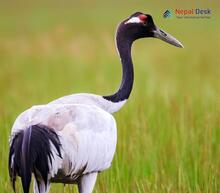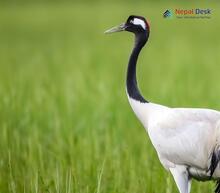Nepal, a country celebrated for its breathtaking landscapes and abundant biodiversity, is home to numerous extraordinary wildlife species. One such marvel is the Grus genus, which consists of large, elegant birds known as cranes. These stunning creatures are a delight to observe, embodying a harmonious blend of beauty, elegance, and remarkable adaptability. Join us as we delve into the captivating world of these magnificent birds residing in Nepal and learn about their traits, habitats, and significance within the local ecosystem.
A Fascinating Profile: Delving into the Grus Genus
As members of the Gruidae family, the Grus genus encompasses various crane species, each defined by their distinct appearances and behaviors. With their long legs, necks, and unique calls, cranes are easily recognizable. These regal birds display diverse plumage that ranges from understated grays or browns to vibrant hues seen on red-crowned cranes.
Cranes are omnivores by nature, feasting on a wide variety of foods including small animals such as insects or rodents, as well as plant-based sources like tubers and grains. They engage in captivating mating rituals marked by elegant dances paired with mesmerizing vocalizations.
The Perfect Home: Crane Habitats in Nepal
Nepal's diverse geographical features make it an ideal haven for different crane species. These mesmerizing birds find sanctuary in various parts of the country - from wetlands and marshes to grasslands and high-altitude plateaus. Notable species residing in Nepal include the Sarus Crane (Grus antigone) and the demoiselle crane (Grus virgo).
The arus Crane can often be spotted in Nepal's lowland areas such as Terai. As the world's tallest flying bird, this graceful creature can reach heights over 5 feet. The demoiselle crane, in contrast, is seen in the higher elevations of Nepal during migration, traversing the awe-inspiring Himalayas to reach their winter destinations.
Protecting These Majestic Birds: Conservation and Local Communities
Cranes face various challenges in maintaining stable populations due to issues like habitat loss and human intervention. To aid these spectacular birds, a number of local and global organizations are working together on conservation strategies aimed at ensuring their continued existence in Nepal. These efforts prioritize habitat preservation, sustainable agricultural practices, and community education regarding the ecological importance of cranes.
Additionally, these captivating birds hold cultural relevance in many areas of Nepal. Local communities regard cranes as symbols of good fortune, longevity, and happiness. This bond between humans and wildlife is crucial to nurturing harmony and an enduring appreciation for the natural wonders of Nepal.
The Grus genus embodies a captivating profile that appeals to nature lovers worldwide. As our understanding of these extraordinary birds in Nepal continues to grow, we must actively support conservation endeavors to protect their well-being and sustain their presence within their picturesque habitats.




